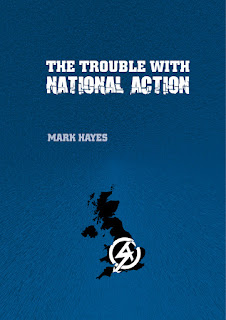Mark Hayes, The Trouble With National Action
London: Freedom Press, 2019
100 pp., £5.00, ISBN: 978-1-904491-34-7
Reviewer: Matthew N. Lyons
The following review is forthcoming in the journal Anarchist Studies and is posted here with their permission.
In 2016, National Action became the first far right organization to be banned by the British government since World War II. Formed in 2013 after the collapse of the British National Party, National Action (NA) never grew beyond a few hundred members at most, but they became notorious for openly glorifying Nazism and advocating violence, bucking the trend by many fascists to embrace a more respectable populist image and electoral strategy.
The Trouble With National Action, by Solent University senior lecturer and former Anti-Fascist Action member Mark Hayes, covers a lot of ground in a scant 18,000 words. The little book not only analyzes the neonazi group’s politics but also uses it as a vehicle to explore important questions about fascism’s relationship with the established economic and political order, state repression, and anti-fascist strategy. The result has its flaws but offers a lot of good and useful arguments.
As Hayes tells it, NA hewed to a fairly classic version of Nazi ideology, in which the white race must be saved from ruin by imposing authoritarian discipline and a sense of collective duty and ruthless struggle, and by purging all foreign and degenerate elements (immigrants, Muslims, homosexuals, disabled people, communists, and above all Jews). NA combined these old school beliefs with a modern, youth-oriented style; an internal culture focused on combat; and a highly aggressive, emotion-driven approach to propaganda. Although rooted in domestic far right traditions of the British Union of Fascists and the National Front, NA also reflected wider fascist influences such as Golden Dawn in Greece and Louis Beam’s concept of leaderless resistance in the United States.
This profile of National Action serves as a useful introduction to neonazi beliefs and culture more generally. Despite a few unfortunate references to fascist activists as “lunatics” or “pathological misfits,” Hayes rightly emphasizes that fascist politics speaks to real needs and grievances, although in perverse ways. It offers a sense of purpose, an explanation for societal decay and deprivation, and a collective identity to counter neoliberalism’s hyper-individualism.
Hayes rejects the false equivalence that many liberals and some leftists have drawn between fascism and militant anti-fascism, arguing that violent confrontation and self-defense against fascists are both justified and necessary. He warns that it is dangerous to rely on the capitalist State to suppress fascist activism, in large part because it validates the growth of the State’s repressive apparatus, which represents a greater authoritarian threat than relatively marginal groups like National Action. Hayes also argues that the official ban on NA is counterproductive because the same fascists continue to organize under other names, and because “the suppression of public-facing activities has exacerbated a turn in the far right towards terrorism” (p. 84). These are all solid and important points.
My main disagreements with Hayes’s book concern fascism’s relationship with the established economic and political order. It’s quite true, as he argues, that fascism is rooted in the contradictions of capitalism, so if we want to truly eliminate the fascist threat we have to replace the capitalist system with one that meets human needs rationally and fairly. But Hayes gives only vague, passing mention to the serious conflicts that have arisen in practice between fascism and capitalist interests—most dramatically the Nazi State’s overriding pursuit of genocide even when it conflicted with the needs of the war economy. And it’s deeply misleading to portray fascism, as Hayes does, as “reactionary conservatism on steroids” (p. 54), because both Italian Fascism and German Nazism brought about profound cultural and political changes, and—in the case of the Nazis—dramatically restructured capitalism without abolishing it. The supremacist and exclusionary vision of contemporary fascist groups like National Action is the opposite of liberatory, but it also clashes with global capitalists’ neoliberal drive to tear down old borders so that they can be free to exploit workers wherever and however they want.
The Trouble With National Action closes with a call for British anti-fascism to “develop new competencies in research and monitoring” (p. 86) to help the movement understand its enemy and develop “a diversity of responses to the diversity of far-right groups it must oppose” (p. 88). I applaud this aim and ask only that it be extended to probe the diversity of contemporary fascists’ complex and contradictory relationships with mainstream politics and established institutions, rather than treat these relationships as one dimensional.
Matthew N. Lyons is the author of Insurgent Supremacists: The U.S Far Right’s Challenge to State and Empire (PM Press and Kersplebedeb Publishing, 2018) and lead contributor to the radical antifascist blog Three Way Fight.
